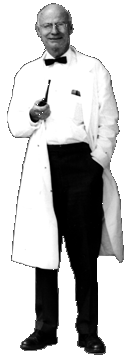1 -
Three Stages in Human Evolution
2 - Stone Age Humans
3 - Greece & Rome
4 - The 17th and 18th Centuries
5 - The Social Reforms of the 19th and 20 Centuries
6 - 1950 to 2000 - The Coming Gerontocracy
7 - The Problem
8 -The
Solution |
 In the 1930s, a small number of
scientists and medical doctors foresaw the coming demographic shift toward
an aged population, and they realized that medicine needed to focus on a
much deeper level than conventional disease pathology - the biology of the
ageing process. Originally, in 1939, they formed an international federation
called the Club for Research on Ageing. One of the founding members was
Nathan Wetherell Shock (1906-1989); and when that Club was superseded in
1945 by the Gerontological Society (of America) Inc., Shock became the first
editor of the society's publication, the Journal of Gerontology. In the 1930s, a small number of
scientists and medical doctors foresaw the coming demographic shift toward
an aged population, and they realized that medicine needed to focus on a
much deeper level than conventional disease pathology - the biology of the
ageing process. Originally, in 1939, they formed an international federation
called the Club for Research on Ageing. One of the founding members was
Nathan Wetherell Shock (1906-1989); and when that Club was superseded in
1945 by the Gerontological Society (of America) Inc., Shock became the first
editor of the society's publication, the Journal of Gerontology.
Obviously, hundreds of people have contributed
to the development of gerontology; and Nathan Shock was not only one of
the "founding fathers" of this discipline; but over the 45+ years
of his scientific career, he was one of the most significant contributors.
It was Shock's insistence on answering what he considered the discipline's
two critical questions that set the fundamental direction of the field of
gerontology: 1) "What are the underlying biological factors that produce
what we perceive as aging?" and, 2) "What are the mechanisms that
produce impaired performance with age?" His work is the basis of testing
and evaluation system of our Life-Extension Program. |
In the 50 years between 1950 and 2000, life-expectancy
increased to 79 years. Thus, in the last century, life-expectancy of the
average person increased by 30 years. Of that amount, 25 years is attributed
to public health measures, as described in slide 4, and 5 years is attributed
to clinical medicine. Most of the improvement has occurred in post natal
and early childhood survival. For example, one-hundred years ago in 1900
when there was not any effective medicine, if you had survived to age 65,
then your life-expectancy would have been 11 years. Today with massive amounts
of medical technology, if you survive to age 65, then your life-expectancy
is 15 years. In other words, there has only been a gain of 4 years over
the last 100 years for those who survive to age 65. And of that additional
4 years, 3 can be attributed to public health factors and 1, to medicine.
Obviously, the massive amount of medicine that is performed on those 65
and older makes no significant contribution to improved life-expectancy.
As can be seen from the survival curves, below,
while the average life-expectancy has increased, there has not been any
real change in the maximum life-span. The reason is that all of the public
health measures and medical practices have not done anything to ameliorate
the underlying process of biological degeneration - i.e., the ageing processes. |